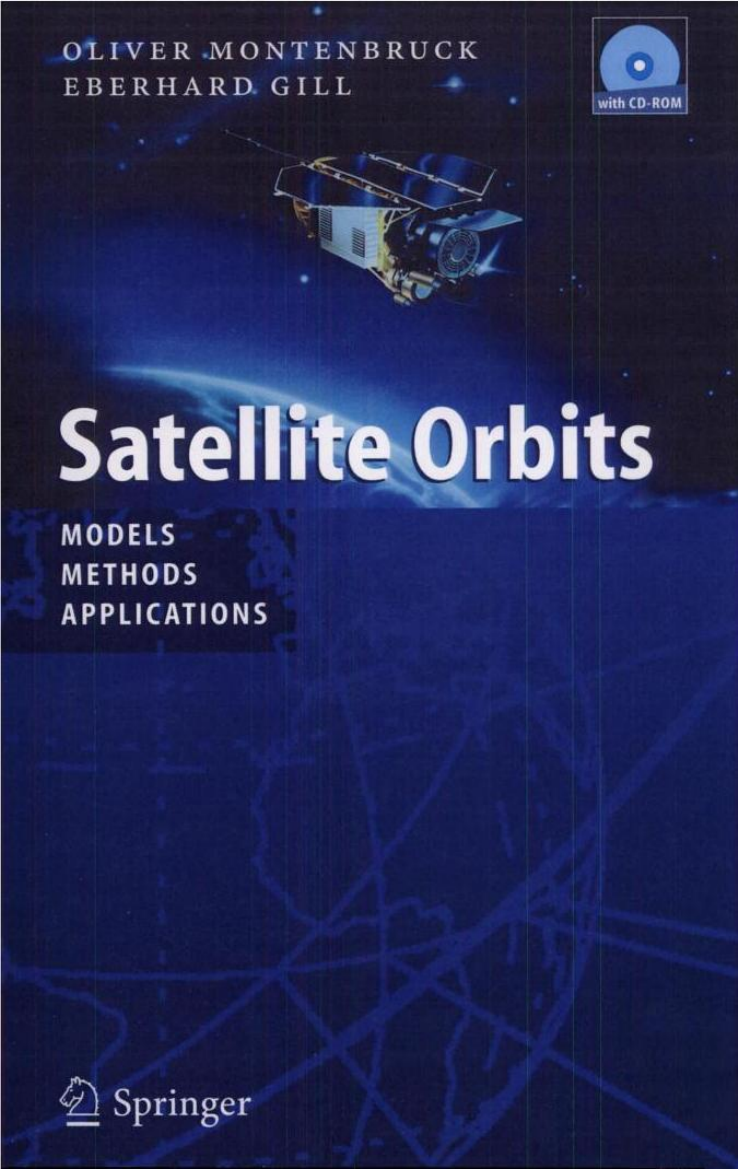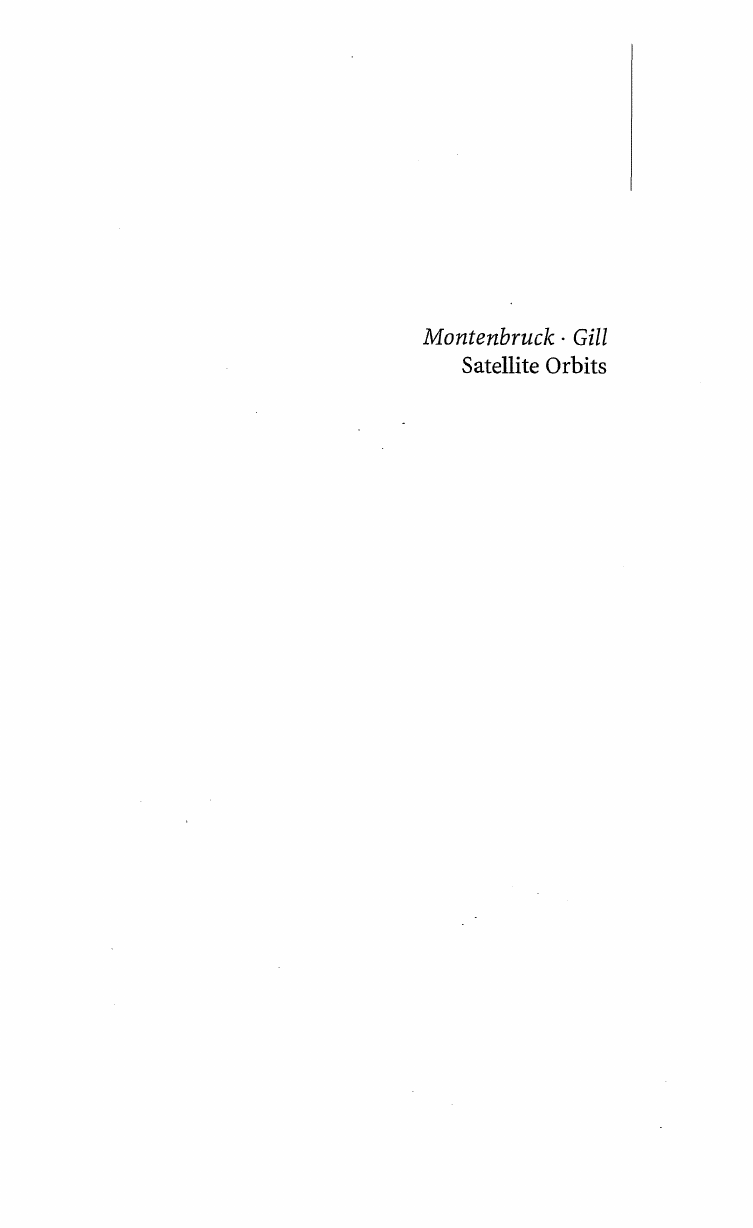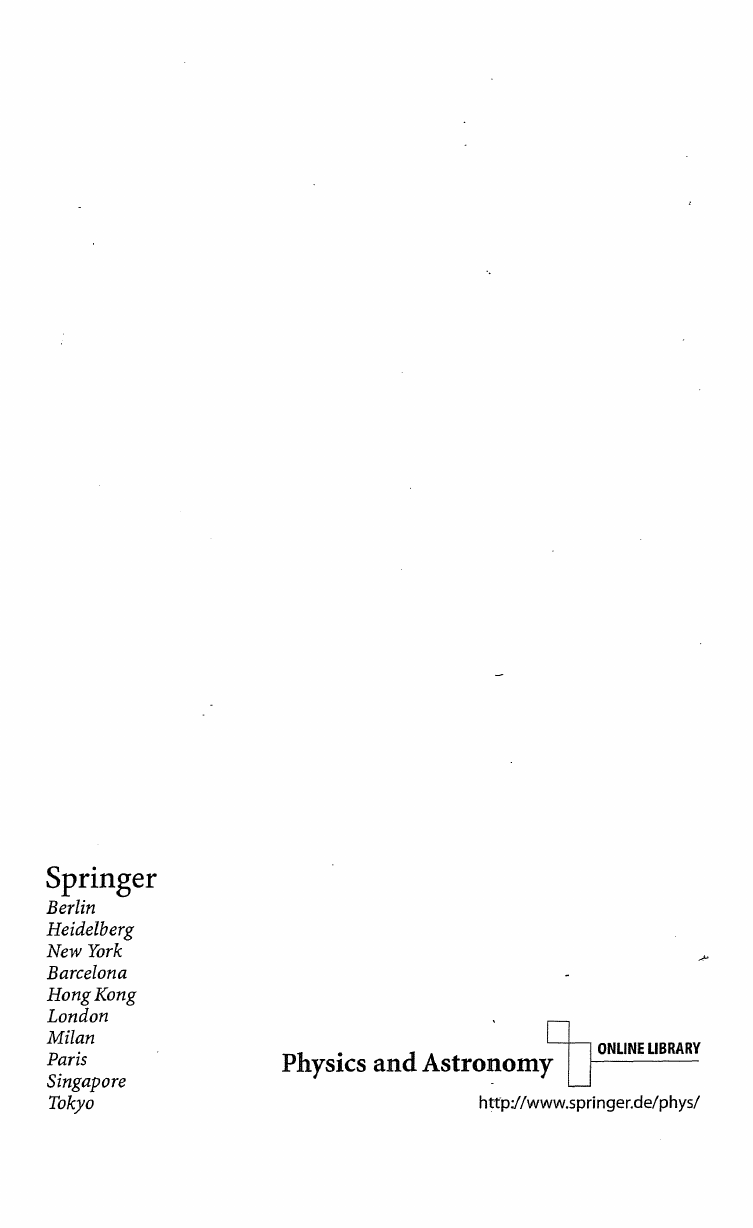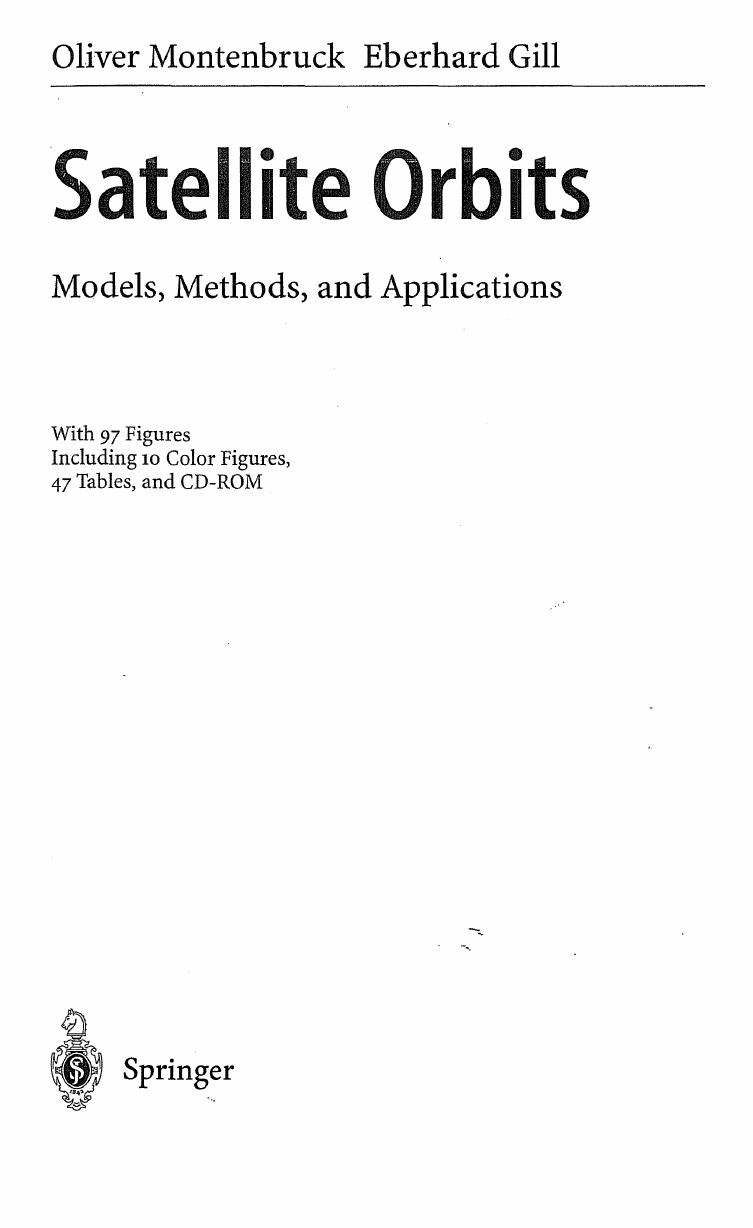SATELLITE ORBITS: MODELS, METHODS, APPLICATIONS
Half-title
Title Page
Copyright Page
Preface
Contents
Chapter 1. Around the World in a Hundred Minutes
1.1 A Portfolio of Satellite Orbits
1.1.1 Low-Earth Orbits
1.1.2 Orbits of Remote Sensing Satellites
1.1.3 Geostationary Orbits
1.1.4 Highly Elliptical Orbits
1.1.5 Constellations
1.2 Navigating in Space
1.2.1 Tracking Systems
1.2.2 A Matter of Effort
Chapter 2. Introductory Astrodynamics
2.1 General Properties of the Two-Body Problem
2.1.1 Plane Motion and the Law of Areas
2.1.2 The Form of the Orbit
2.1.3 The Energy Integral
2.2 Prediction of Unperturbed Satellite Orbits
2.2.1 Kepler's Equation and the Time Dependence of Motion
2.2.2 Solving Kepler's Equation
2.2.3 The Orbit in Space
2.2.4 Orbital Elements from Position and Velocity
2.2.5 Non-Singular Elements
2.3 Ground-Based Satellite Observations
2.3.1 Satellite Ground Tracks
2.3.2 Satellite Motion in the Local Tangent Coordinate System
2.4 Preliminary Orbit Determination
2.4.1 Orbit Determination from Two Position Vectors
2.4.2 Orbit Determination from Three Sets of Angles
Exercises
Chapter 3. Force Model
3.1 Introduction
3.2 Geopotential
3.2.1 Expansion in Spherical Harmonics
3.2.2 Some Special Geopotential Coefficients
3.2.3 Gravity Models
3.2.4 Recursions
3.2.5 Acceleration
3.3 Sun and Moon
3.3.1 Perturbing Acceleration
3.3.2 Low-Precision Solar and Lunar Coordinates
3.3.3 Chebyshev Approximation
3.3.4 JPL Ephemerides
3.4 Solar Radiation Pressure
3.4.1 Eclipse Conditions
3.4.2 Shadow Function
3.5 Atmospheric Drag
3.5.1 The Upper Atmosphere
3.5.2 The Harris–Priester Density Model
3.5.3 The Jacchia 1971 Density Model
3.5.4 A Comparison of Upper Atmosphere Density Models
3.5.5 Prediction of Solar and Geomagnetic Indices
3.6 Thrust Forces
3.7 Precision Modeling
3.7.1 Earth Radiation Pressure
3.7.2 Earth Tides
3.7.3 Relativistic Effects
3.7.4 Empirical Forces
Exercises
Chapter 4. Numerical Integration
4.1 Runge–Kutta Methods
4.1.1 Introduction
4.1.2 General Runge–Kutta Formulas
4.1.3 Stepsize Control
4.1.4 Runge–Kutta–Nyström Methods
4.1.5 Continuous Methods
4.1.6 Comparison of Runge–Kutta Methods
4.2 Multistep Methods
4.2.1 Introduction
4.2.2 Adams–Bashforth Methods
4.2.3 Adams–Moulton and Predictor–Corrector Methods
4.2.4 Interpolation
4.2.5 Variable Order and Stepsize Methods
4.2.6 Stoermer and Cowell Methods
4.2.7 Gauss–Jackson or Second Sum Methods
4.2.8 Comparison of Multistep Methods
4.3 Extrapolation Methods
4.3.1 The Mid-Point Rule
4.3.2 Extrapolation
4.3.3 Comparison of Extrapolation Methods
4.4 Comparison
Exercises
Chapter 5. Time and Reference Systems
5.1 Time
5.1.1 Ephemeris Time
5.1.2 Atomic Time
5.1.3 Relativistic Time Scales
5.1.4 Sidereal Time and Universal Time
5.2 Celestial and Terrestrial Reference Systems
5.3 Precession and Nutation
5.3.1 Lunisolar Torques and the Motion of the Earth's Rotation Axis
5.3.2 Coordinate Changes due to Precession
5.3.3 Nutation
5.4 Earth Rotation and Polar Motion
5.4.1 Rotation About the Celestial Ephemeris Pole
5.4.2 Free Eulerian Precession
5.4.3 Observation and Extrapolation of Polar Motion
5.4.4 Transformation to the International Reference Pole
5.5 Geodetic Datums
Exercises
Chapter 6. Satellite Tracking and Observation Models
6.1 Tracking Systems
6.1.1 Radar Tracking
6.1.2 Laser Tracking
6.1.3 The Global Positioning System
6.2 Tracking Data Models
6.2.1 Transmitter and Receiver Motion
6.2.2 Angle Measurements
6.2.3 Range Measurements
6.2.4 Doppler Measurements
6.2.5 GPS Measurements
6.3 Media Corrections
6.3.1 Interaction of Radiation and Atmosphere
6.3.2 Tropospheric Refraction
6.3.3 Ionospheric Refraction
Exercises
Chapter 7. Linearization
7.1 Two-Body State Transition Matrix
7.1.1 Orbital-Elements Transition Matrix
7.1.2 Keplerian-to-Cartesian Partial Derivatives
7.1.3 Cartesian-to-Keplerian Partial Derivatives
7.1.4 The State Transition Matrix and Its Inverse
7.2 Variational Equations
7.2.1 The Differential Equation of the State Transition Matrix
7.2.2 The Differential Equation of the Sensitivity Matrix
7.2.3 Form and Solution of the Variational Equations
7.2.4 The Inverse of the State Transition Matrix
7.3 Partial Derivatives of the Acceleration
7.3.1 Geopotential
7.3.2 Point-Mass Perturbations
7.3.3 Solar Radiation Pressure
7.3.4 Drag
7.3.5 Thrust
7.4 Partials of the Measurements with Respect to the State Vector
7.5 Partials with Respect to Measurement Model Parameters
7.6 Difference Quotient Approximations
Exercises
Chapter 8. Orbit Determination and Parameter Estimation
8.1 Weighted Least-Squares Estimation
8.1.1 Linearization and Normal Equations
8.1.2 Weighting
8.1.3 Statistical Interpretation
8.1.4 Consider Parameters
8.1.5 Estimation with A Priori Information
8.2 Numerical Solution of Least-Squares Problems
8.2.1 QR Factorization
8.2.2 Householder Transformations
8.2.3 Givens Rotations
8.2.4 Singular Value Decomposition
8.3 Kalman Filtering
8.3.1 Recursive Formulation of Least-Squares Estimation
8.3.2 Sequential Estimation
8.3.3 Extended Kalman Filter
8.3.4 Factorization Methods
8.3.5 Process Noise
8.4 Comparison of Batch and Sequential Estimation
Exercises
Chapter 9. Applications
9.1 Orbit Determination Error Analysis
9.1.1 A Linearized Orbit Model
9.1.2 Consider Covariance Analysis
9.1.3 The GEODA Program
9.1.4 Case Studies
9.2 Real-Time Orbit Determination
9.2.1 Model and Filter Design
9.2.2 The RTOD Program
9.2.3 Case Studies
9.3 Relay Satellite Orbit Determination
9.3.1 Mathematical Models
9.3.2 The TDRSOD Program
9.3.3 Case Study
Appendix A
A.1 Calendrical Calculations
A.1.1 Modified Julian Date from the Calendar Date
A.1.2 Calendar Date from the Modified Julian Date
A.2 GPS Orbit Models
A.2.1 Almanac Model
A.2.2 Broadcast Ephemeris Model
Appendix B
B.1 Internet Resources
B.2 The Enclosed CD-ROM
B.2.1 Contents
B.2.2 System Requirements
B.2.3 Executing the Programs
B.2.4 Compilation and Linking
B.2.5 Index of Library Functions
List of Symbols
References
Index
Back Cover
















 2023年江西萍乡中考道德与法治真题及答案.doc
2023年江西萍乡中考道德与法治真题及答案.doc 2012年重庆南川中考生物真题及答案.doc
2012年重庆南川中考生物真题及答案.doc 2013年江西师范大学地理学综合及文艺理论基础考研真题.doc
2013年江西师范大学地理学综合及文艺理论基础考研真题.doc 2020年四川甘孜小升初语文真题及答案I卷.doc
2020年四川甘孜小升初语文真题及答案I卷.doc 2020年注册岩土工程师专业基础考试真题及答案.doc
2020年注册岩土工程师专业基础考试真题及答案.doc 2023-2024学年福建省厦门市九年级上学期数学月考试题及答案.doc
2023-2024学年福建省厦门市九年级上学期数学月考试题及答案.doc 2021-2022学年辽宁省沈阳市大东区九年级上学期语文期末试题及答案.doc
2021-2022学年辽宁省沈阳市大东区九年级上学期语文期末试题及答案.doc 2022-2023学年北京东城区初三第一学期物理期末试卷及答案.doc
2022-2023学年北京东城区初三第一学期物理期末试卷及答案.doc 2018上半年江西教师资格初中地理学科知识与教学能力真题及答案.doc
2018上半年江西教师资格初中地理学科知识与教学能力真题及答案.doc 2012年河北国家公务员申论考试真题及答案-省级.doc
2012年河北国家公务员申论考试真题及答案-省级.doc 2020-2021学年江苏省扬州市江都区邵樊片九年级上学期数学第一次质量检测试题及答案.doc
2020-2021学年江苏省扬州市江都区邵樊片九年级上学期数学第一次质量检测试题及答案.doc 2022下半年黑龙江教师资格证中学综合素质真题及答案.doc
2022下半年黑龙江教师资格证中学综合素质真题及答案.doc